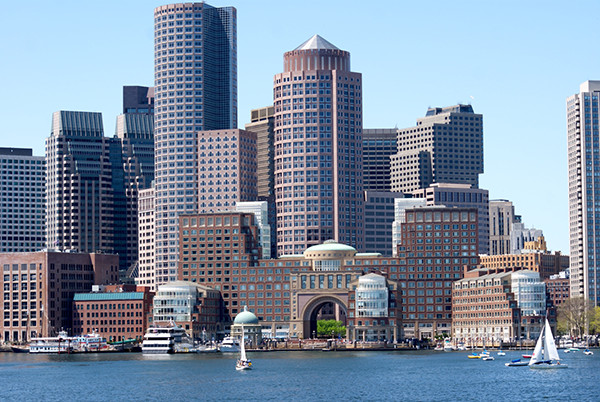
by Rossie Izlar Friday, June 16, 2017

The Northeast, including Boston, is projected to warm more quickly over the next few decades than the contiguous U.S. as a whole, according to a recent study. Credit: bobwright, CC0
The U.S. Northeast and Midwest will warm quickly in the coming decades compared to national and global averages, reaching established temperature benchmarks sooner than most of the rest of the country, and the world, according to recent research published in PLOS ONE.
Under the Paris Agreement, to date ratified by 148 of the nearly 200 countries that negotiated the deal, national governments pledged to do what they could to limit the rise of global mean temperatures to less than 2 degrees Celsius above preindustrial levels.
“Since the Paris Agreement, people have been focusing a lot on limiting warming to below 2 degrees Celsius,” says Ambarish Karmalkar, a geoscientist at the University of Massachusetts, Amherst (UMass), and lead author of the new study. This target offers a tangible goal, he says, although most climate scientists agree the planet’s average temperature will probably cross this threshold regardless of the agreement.
Still, because “global warming rates differ around the world,” Karmalkar says, it’s important to focus on regional- and local-scale projections, which will help local stakeholders plan for changes to ecology, agriculture and hydrology in their areas. “The impacts of climate change happen locally,” he says. “So it makes sense to give local planners as much information as possible.”
Karmalkar and Raymond Bradley, also a geoscientist at UMass, wanted to know when different regions in the U.S. are likely to reach the Paris Agreement benchmark. To investigate future conditions in the U.S., the researchers relied on simulations from the Coupled Model Intercomparison Project (CMIP5), an international collaboration to develop climate models validated against past climate observations.
They used 32 different CMIP5 models, comparing outcomes under two possible scenarios: a “high” greenhouse gas emissions scenario in which emissions continue to increase through the 21st century, and a “medium” scenario in which emissions rise more slowly than in the high scenario until mid-century when they plateau and then begin decreasing. In particular, Karmalkar and Bradley looked at when different parts of the U.S. will have warmed by 1.5 degrees and 2 degrees Celsius over preindustrial temperatures. (Small island nations, which are disproportionally affected by global warming and sea-level rise, pushed for a 1.5-degree-Celsius limit during the Paris Agreement. This limit is considered a long-term “aspirational” goal.)
The researchers found that in both emissions scenarios, the contiguous United States as a whole reaches the Paris benchmarks at least a decade earlier than the global average. The U.S. ensemble mean temperature — the average of all projections under both scenarios — reaches 1.5 degrees warmer by the early 2020s, and 2 degrees warmer in the early- to mid-2030s.
Karmalkar says it isn’t surprising that temperatures in the U.S. and other continental areas should outpace global averages because air over land warms faster than air over the ocean, yet temperatures over both continents and oceans contribute to the average. However, he says he was surprised to see the differences among U.S. regions that emerged from the modeling. For example, the Northeast is expected to warm by 2 degrees Celsius roughly 15 years earlier than the South.
The Northeast and the Midwest will warm fastest, according to the research, with each warming by at least 2.5 degrees Celsius by the time the global average warms by 2 degrees. Meanwhile, the South, Southwest and Great Plains will warm slower than the contiguous U.S. average, although more than 80 percent of the models projected that all U.S. regions will warm by at least 2 degrees Celsius by 2050 under the high emissions scenario.
Karmalkar says he and Bradley have a few ideas about why the Northeast and the Midwest are likely to warm faster than elsewhere in the country, including an overall reduction in snow cover. “As a region warms, more of the precipitation that you get is rain,” he says. “That reduces snow cover on the ground, which [further] increases the rate of warming.” Because the Northeast and the Midwest are typically snowier than much of the rest of the country, these regions may be disproportionately impacted by this effect. Karmalkar says the Northeast may also be affected by the nearby Gulf of Maine, which has warmed faster than 99 percent of the ocean in the last 10 years.
The temperature trends in the study appear robust, Karmalkar says, although he notes that there is uncertainty in the findings, as with all climate modeling, particularly on smaller scales. Under each of the emissions scenarios, for example, some models disagree when the U.S. as a whole will cross the 2-degree benchmark. But evaluating many different models all simulating the same thing and looking for agreement among them is how researchers minimize uncertainty, he says.
Monitoring climate change on scales relevant to local decision-making is a current challenge for climate scientists, says Ed Hawkins, a climate scientist at the U.K. National Center for Atmospheric Science. “At small scales, the effects of weather and natural fluctuations become more important [in climate modeling], and, automatically, it becomes harder to predict.” Picking apart why some models disagree is also important, because the stakes are high, he says. “There’s a lot of focus on global mean temperature, but if we are trying to think about policy decisions then we have to figure out what’s going on at a smaller scale.”
© 2008-2021. All rights reserved. Any copying, redistribution or retransmission of any of the contents of this service without the expressed written permission of the American Geosciences Institute is expressly prohibited. Click here for all copyright requests.